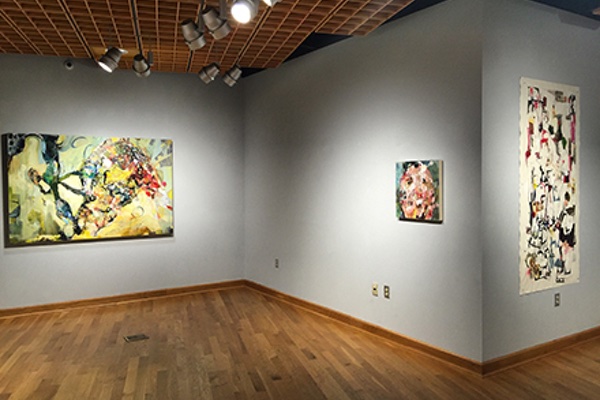The Making of Three Works
By Kim Rae Taylor
See her work in WTP Vol. V #1
Study 1
The shapes and textures that compose the surfaces of my paintings and drawings tend to be found within the natural world. I take reference photos of these elements and then look to the array of collage media I’ve collected to merge them together. A recent painting evolved from photos I snapped while walking, often looking down, on a weekend in Provincetown, Massachusetts.
References
[one_half]Reference 1:
The gold pattern of the lichen against the gray of the stone became inspiration for an overall palette; in particular, how the gray and gold interacted.[/one_half][one_half_last] [/one_half_last]
[/one_half_last]
[one_half]Reference 2:
A cluster of broken shells hidden between rocks caught my attention because the smaller shell shapes seemed to collectively create a singular form.[/one_half][one_half_last] [/one_half_last]
[/one_half_last]
[one_half]Reference 3:
Crushed bits of pottery and pebbles had a textural quality that seemed to shimmer. I also liked the random pieces of reds and darker hues that stood apart from the lighter ones.[/one_half][one_half_last] [/one_half_last]
[/one_half_last]
The Painting
[one_half] [/one_half][one_half_last]Painting Detail 1:
[/one_half][one_half_last]Painting Detail 1:
As I began to layer the collage materials, within the drawing’s lines I incorporated castoff bits, nothing more than litter I picked up just walking from one place to another. As these scraps found their way into the painting, I looked for relationships between certain shapes, textures and colors. I also began to paint on and around the added media to more cohesively embed into the surface.[/one_half_last]
[one_half] [/one_half][one_half_last]Painting Detail 2:
[/one_half][one_half_last]Painting Detail 2:
In building upon the image, the initial form began to look too specific. The abstractions didn’t feel as evocative of nature.[/one_half_last]
[one_half] [/one_half][one_half_last]Painting Detail 3:
[/one_half][one_half_last]Painting Detail 3:
I recognized a face and limbs, a reference to subject matter that’s too literal. I asked others what they saw, and a bird with a tree was described more than once. These comparisons became distractions, so I flipped the painting upside down.[/one_half_last]
[one_half] [/one_half][one_half_last]Painting Detail 4:
[/one_half][one_half_last]Painting Detail 4:
This seemed to solve my problem, so I continued to integrate textual elements within the forms. This contrast established a dialogue of sorts, between the natural and the man-made. As the imagery progressed, the yellow hues of ochre, Naples yellow, and raw sienna provided a touchstone to the golden lichens I wanted to reference.[/one_half_last]
[one_half] [/one_half][one_half_last]Painting Detail 5:
[/one_half][one_half_last]Painting Detail 5:
Shifting values in the background, with charcoal and ink, brought the painting to completion. Though the end result may not speak directly to my original points of reference, I recognize those visual cues.[/one_half_last][gap]
Study 2
[one_half]Though nature provides points of reference, I also sometimes find inspiration around my cluttered studio. This helps facilitate new ideas and allows me to feel comfortable with recycling old drawings and paintings so I can reimagine them into new pieces.[/one_half][one_half_last] [/one_half_last]
[/one_half_last]
The Painting
[one_half] [/one_half][one_half_last]Painting Detail 1:
[/one_half][one_half_last]Painting Detail 1:
This is one such painting that began with collage pieces, old pen and ink drawings, and an encaustic monoprint I cut up. I also incorporated fabric and a small piece of cardboard. Combining these elements is like fitting pieces of a puzzle together and it’s just the start of a process that I think of as dialogue.[/one_half_last]
[one_half] [/one_half][one_half_last]Painting Detail 2:
[/one_half][one_half_last]Painting Detail 2:
In the end, the majority of these elements are not just deconstructed and reconstructed. The build up of paint and other media ultimately conceal the initial collage. This is often how my work will evolve. It’s this part of the process that surprises me once the image is finished.[/one_half_last][gap]
Study 3
[one_half] [/one_half][one_half_last]Painting Detail 1: Sometimes a painting may begin with a single, random idea and develop quickly—I think I finished this in about a week. I was playing with the word “allocate” and the phrase “a lot of cake,” and I really just wanted a face to emerge that would somehow evoke those words mashed up together.[/one_half_last]
[/one_half][one_half_last]Painting Detail 1: Sometimes a painting may begin with a single, random idea and develop quickly—I think I finished this in about a week. I was playing with the word “allocate” and the phrase “a lot of cake,” and I really just wanted a face to emerge that would somehow evoke those words mashed up together.[/one_half_last]
[one_half] [/one_half][one_half_last]Painting Detail 2:
[/one_half][one_half_last]Painting Detail 2:
As the collage media gradually found a place within the egg-like shape, fabric and pieces from a torn chocolate bar wrapper influenced the painting’s final states.[/one_half_last]
[one_half] [/one_half][one_half_last]Painting Detail 3:
[/one_half][one_half_last]Painting Detail 3:
The acidic, candy-like palette supports my initial idea, and a head with ambiguous facial features revealed itself.
Title: “Allocate a lot of Cake,” 2016. Mixed media on panel, 18″ x 18”[/one_half_last][gap]
And finally, a gallery view of the three completed works:


